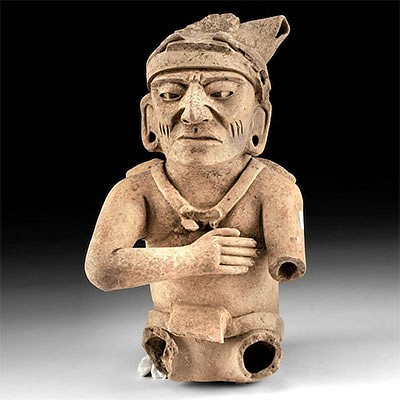Signed John Solem Viscosity Etching - "Near Cottonwood"
Lot 227
About Seller
Artemis Fine Arts
686 S Taylor Ave, Ste 106
Louisville, CO 80027
United States
Selling antiquities, ancient and ethnographic art online since 1993, Artemis Gallery specializes in Classical Antiquities (Egyptian, Greek, Roman, Near Eastern), Asian, Pre-Columbian, African / Tribal / Oceanographic art. Our extensive inventory includes pottery, stone, metal, wood, glass and textil...Read more
Categories
Estimate:
$900 - $1,350
Absentee vs Live bid
Two ways to bid:
- Leave a max absentee bid and the platform will bid on your behalf up to your maximum bid during the live auction.
- Bid live during the auction and your bids will be submitted real-time to the auctioneer.
Bid Increments
| Price | Bid Increment |
|---|---|
| $0 | $25 |
| $300 | $50 |
| $1,000 | $100 |
| $2,000 | $250 |
| $5,000 | $500 |
| $10,000 | $1,000 |
| $20,000 | $2,500 |
| $50,000 | $5,000 |
| $100,000 | $10,000 |
| $200,000 | $20,000 |
About Auction
By Artemis Fine Arts
Feb 3, 2022
Set Reminder
2022-02-03 10:00:00
2022-02-03 10:00:00
America/New_York
Bidsquare
Bidsquare : VARIETY SALE | Ancient, Asian, Ethnographic
https://www.bidsquare.com/auctions/artemis-gallery/variety-sale-ancient-asian-ethnographic-8833
Join us for our first sale of February with a spotlight on two fabulous collections, one from Lumberton, Texas, and the other from Whisnant Gallery in New Orleans. Artemis Fine Arts info@artemisgallery.com
Join us for our first sale of February with a spotlight on two fabulous collections, one from Lumberton, Texas, and the other from Whisnant Gallery in New Orleans. Artemis Fine Arts info@artemisgallery.com
- Lot Description
John Solem (American, d. 2014). "Near Cottonwood" viscosity etching. Signed, titled, and numbered 7/40 in pencil at lower right. Ca. late 20th century. This original, limited edition viscosity etching is from John Solem's "Wilderness Spirit" collection which captured his direct exploration of nature in Alaska, the High Sierra, the Canadian wilderness, and the Grand Canyon over a period of 30 years. By using the viscosity printing process (see more about viscosity printing below) Solem created an image in bas relief presenting a topographical view of the region with rock cliffs and other geographical formations as well as a leafy Cottonwood branch at the upper left. All is delineated in a striking color palette with shades of rose, claret, acorn brown, royal blue, sage, forest green, black, and white. Size of viscosity etching: 29.75" L x 39.75" W (75.6 cm x 101 cm) Size of frame: 37" L x 47.2" W (94 cm x 119.9 cm)
In 2003, John Solem had a solo exhibition at the Kwan Fong Gallery at California Lutheran University. The curators wrote the following, "Solem is a faculty emeritus of the CLU Art Department and a resident of Yosemite Lakes Park north of Fresno. The 'Wilderness Spirit' collection represents his direct experience with nature in Alaska, the High Sierra, the Canadian Wilderness and the Grand Canyon over the last 30 years. His artwork is best actualized through the flow of the sensory experiences with the natural world and shows a deep spiritual relationship between the artist and the wilderness."
Viscosity printing is a sophisticated technique that combines the principles of relief and intaglio printing. It was developed by Stanley William Hayter in Paris in the late 1960s. Viscosity by definition is a fluid's ability to resist flow. The artist can print multiple colors of ink from a single plate instead of using multiple plates to ensure color separation. The artist either scratches or etches a metal plate with acid, and then introduces a viscous ink that possesses the consistency of oil paint into the grooves. Then the polished surface is wiped clean with a cloth and newsprint. Once this is done, the ink only remains below the plate level. Following this, the artist covers the plate with a damp paper and felt blankets and runs it through a press. The immense pressure pushes the paper into the etched grooves to receive the ink. The result is that the ink that was once below the plate's surface is now embossed on the paper to create a relief surface.
Provenance: private Ventura County, California, USA collection
All items legal to buy/sell under U.S. Statute covering cultural patrimony Code 2600, CHAPTER 14, and are guaranteed to be as described or your money back.
A Certificate of Authenticity will accompany all winning bids.
b>PLEASE NOTE: Due to recent increases of shipments being seized by Australian & German customs (even for items with pre-UNESCO provenance), we will no longer ship b>PLEASE NOTE: Due to recent increases of shipments being seized by Australian & German customs (even for items with pre-UNESCO provenance), we will no longer ship firm.
Display stands not described as included/custom in the item description are for photography purposes only and will not be included with the item upon shipping.
#168387Signed, titled, and numbered 7/40 in pencil at lower right. Some minor creases to the sheet as shown. Small loss to lower area of etched imagery - left of center - as shown. Area of abrasion at upper right of sheet that is not over the etched imagery. Minor stains to the matte. Frame has a few scuffs and is missing glass but is otherwise intact and fitted with a suspension wire.Condition
- Shipping Info
-
All shipping is handled in-house for your convenience. Your invoice from Artemis Gallery will include shipping calculation instructions. If in doubt, please inquire BEFORE bidding for estimated shipping costs for individual items.
-
- Buyer's Premium



 EUR
EUR CAD
CAD AUD
AUD GBP
GBP MXN
MXN HKD
HKD CNY
CNY MYR
MYR SEK
SEK SGD
SGD CHF
CHF THB
THB














